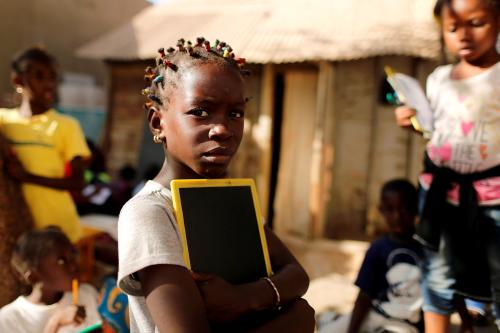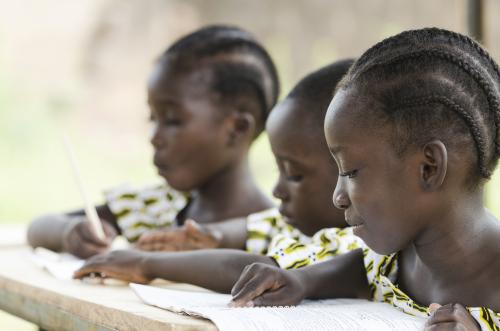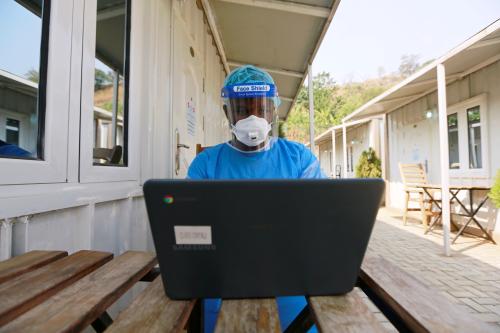The Nigerian education system is deep into crises on multiple fronts, including in areas of access and quality of education. However, the recent spate of mass kidnappings of schoolchildren arguably represents the gravest existential threat and crisis to the education system. In less than three months between December 2020 and March 2021, more than 600 children have been kidnapped while in school, in three separate incidents.
More worrisome is the fact that the heightened insecurity is predominant in northern Nigeria, which is already the most educationally disadvantaged region. Of the estimated 10.5 million out-of-school children in the country, 69 percent come from the North, where cultural practices and economic deprivation limit children’s active participation in school, particularly females. The Boko Haram crisis, with its debilitating effects on economic and education systems, is also heavily concentrated in the region. Now, with the spate of recent school kidnappings, community and parental trust in the education system could shrink significantly, and the problem of access to quality and equitable education could become severely amplified. Furthermore, with the Nigerian education system still recovering from the devastating effects of the prolonged school closure from COVID-19, adding insecurity concerns to the basket of challenges could lead to its irrecoverable collapse.
Nigerian policymakers, school leaders, and communities must effectively and creatively come together to help reverse the current economic and education dynamics to avoid a catastrophic collapse.
Steps to make schools safer again
Targeted kidnapping of schoolchildren began in 2014 with the mass abduction of 276 female students in Chibok by Boko Haram insurgents. That event was ideologically motivated, and designed to extort concessions from the government. Recently, abductions have become more profit-driven, involving organized and unorganized criminal groups. The profit dimension to the kidnappings can easily complicate Nigeria’s security problems, as they could become more frequent given the high level of poverty and youth unemployment in the region amid the stark absence of legitimate economic opportunities. If education is to survive, it is crucial to urgently change the current dynamics and make schools safe again. This crisis requires swift and comprehensive action, both in prevention and supporting victims to minimize long-term damages. While the scope for improvement is vast and complex, here we outline four focus areas that—if addressed—might garner meaningful traction toward avoiding future school kidnappings and averting the further dismantling of education in Nigeria’s North.
1. Comprehensive threat assessment of schools in the entire Northern region, with subsequent closures and relocation
In all areas of the North, even those removed from the Boko Haram-controlled Northeast, numerous armed groups are increasingly seeing the potential to “cash in” on insecure schools through a “kidnap and ransom” approach. Conducting a threat assessment in all areas of the country deemed vulnerable to such armed groups—including evaluating the location of the schools, their relationship to the surrounding communities (through consultations with local traditional leaders), and the state of their infrastructure—should be a first step to assessing which schools are most at risk. Institutions determined to be unsafe should immediately be shut, with contingency plans in place to facilitate temporary alternative learning arrangements (here the lessons learned during the COVID-19 crisis may be useful), together with strategies for relocating students to safer environments. Preventing more kidnappings should be the priority, not only for the welfare of potential future victims, but also with a view to salvaging any remaining public confidence in the safety of schools and avoiding further insecurity-related dropouts, which Nigeria’s education system can ill afford.
2. The development of a strong community support network to ensure affected communities are not left behind
Children and their parents who fall victim to armed kidnapping groups cannot be left unaided. Ensuring that they mentally recover from their trauma should be a central tenet of any intervention strategy that seeks to limit the adverse impacts of kidnappings on education. Children need strong community support networks tailored to the needs of children in conflict zones, including the training of teachers to help students recover from traumatic experiences and a greater availability of guidance counselors experienced in assisting trauma victims. If children are not to become permanently disillusioned with education, the fostering of positive emotions through affirmative training and building happier school-associated memories is crucial.
3. A reevaluation and revamping of the Safe Schools Initiative
The Safe Schools Initiative (SSI) was launched with much fanfare in the aftermath of the globally publicized abduction of the Chibok girls by Boko Haram in 2014. After a promising start—including several tens of millions of dollars pledged by a coalition of the Nigerian government, international donors, and Nigerian business leaders; a plan to relocate students in high-risk areas; and strategies to strengthen education in camps for internally displaced persons (IDPs)—it remains unclear how impactful the program has been so far.
While evidence of SSI’s success is lacking, this should not automatically lead to a disregard of its main principles. A reevaluation of its strong points, including its emphasis on the training of school staff to deal with emergencies and a focused extension of the initiative beyond the original scope for only the BAY states (Boko Haram mainly operate in Borno, Adamawa, and Yobe states), should be examined. The SSI was originally designed with the aid of international organizations such as UNESCO, and the government should not shy away from leaning on the foundations of a program that, if well-managed and sufficiently funded, could be effective in the North.
4. Addressing the long-term insecurity threat
The importance of dealing with the surge of economically motivated school kidnappings directly in schools cannot be understated. However, it is naive to assume that a school- or community-level intervention could suffice in the long run. Nigeria continues to suffer from perennial multipronged insecurities ranging from terrorism—there were at least 1,600 terrorism-caused deaths in the 11 months between January and November 2020—to the violent, ethnically tinged herder-farmer communal conflicts over agricultural land, which kill several thousands of people yearly. Without a comprehensive strategy to deal with the persistent state of violence, including a coherent plan to regain control of Nigeria’s “ungoverned spaces,” imagining a safe space for education is difficult.
Schools are only safe in so far as the larger society is safe. Nigerian policymakers, school leaders, and communities must effectively and creatively come together to help reverse the current economic and education dynamics to avoid a catastrophic collapse.







Commentary
Student kidnappings threaten collapse of Nigerian education system
April 19, 2021